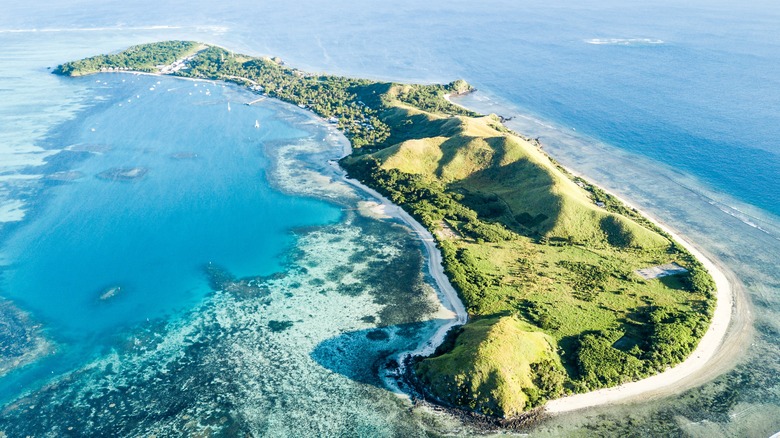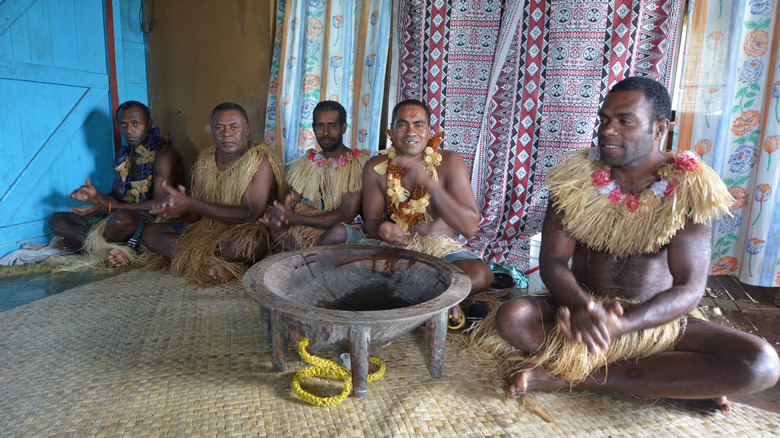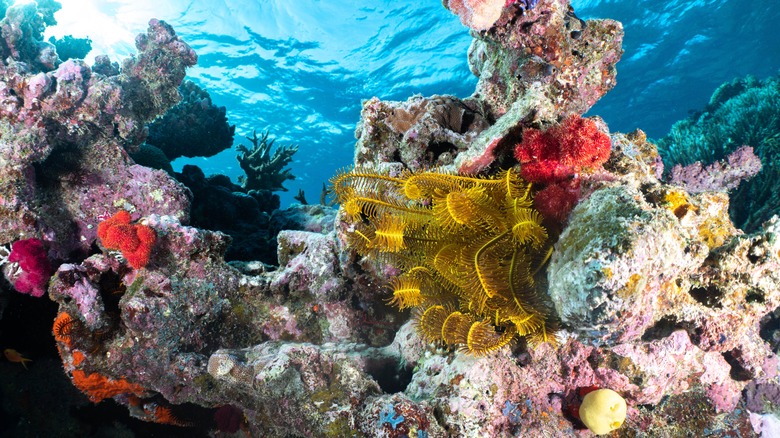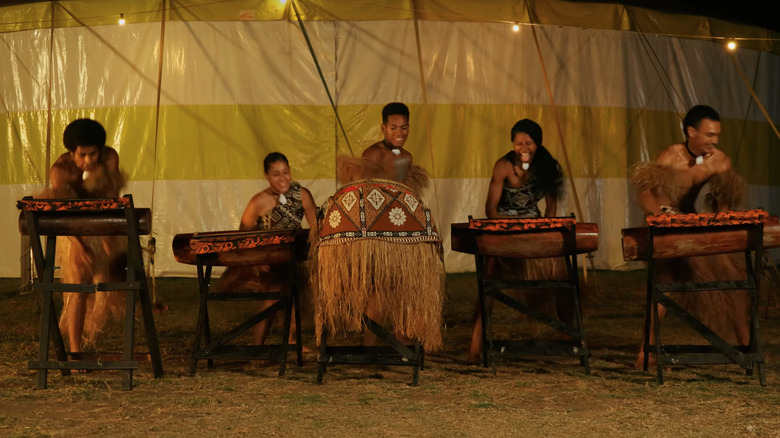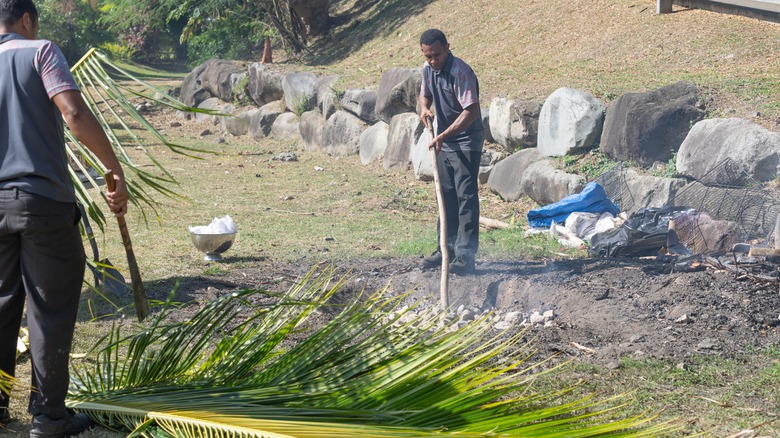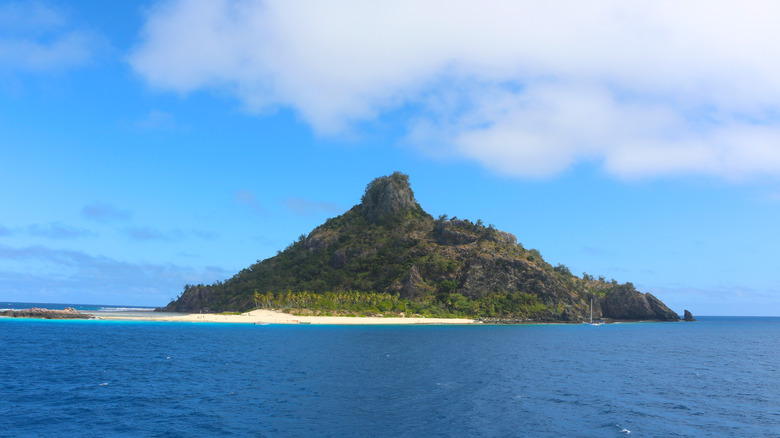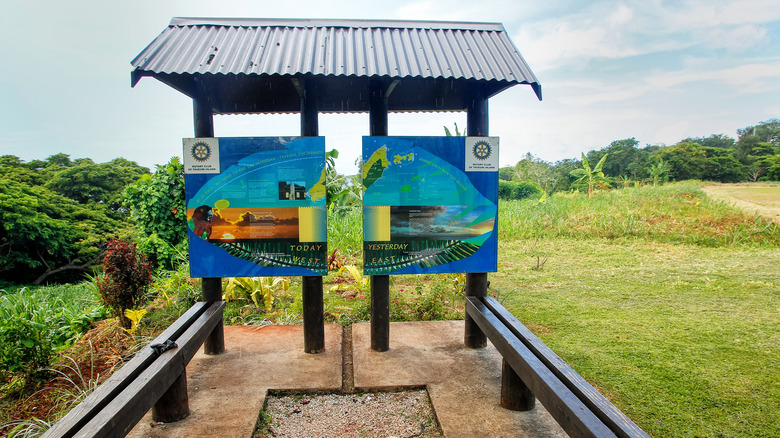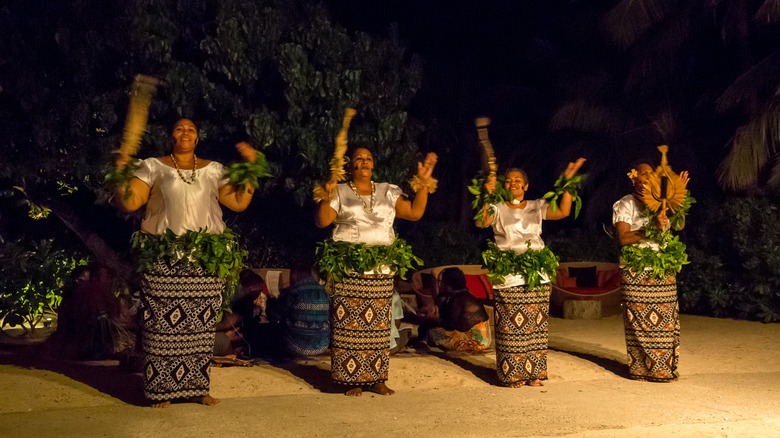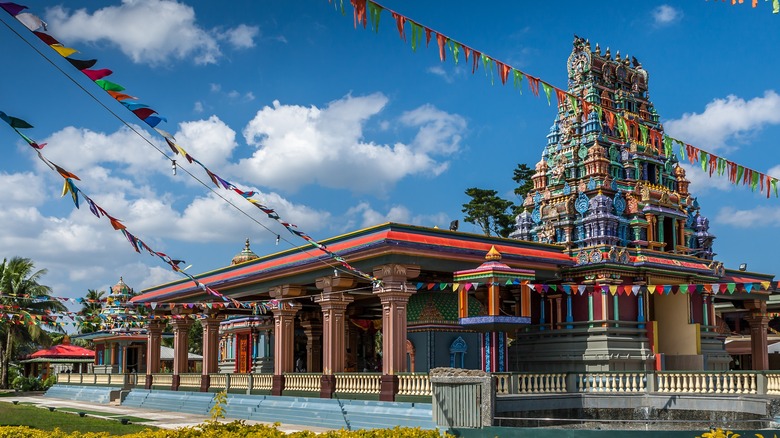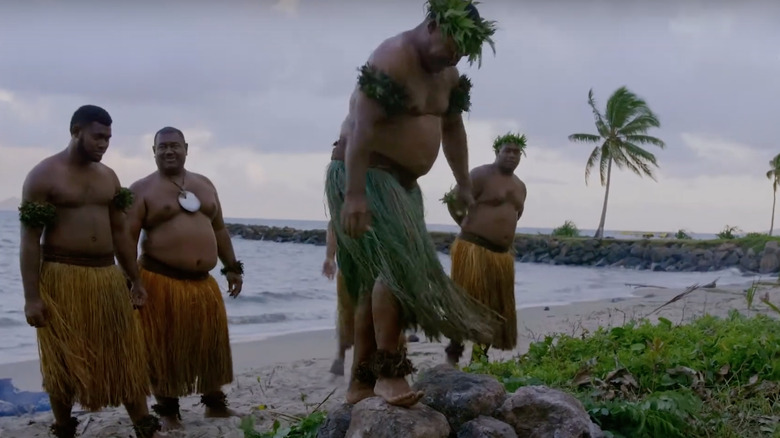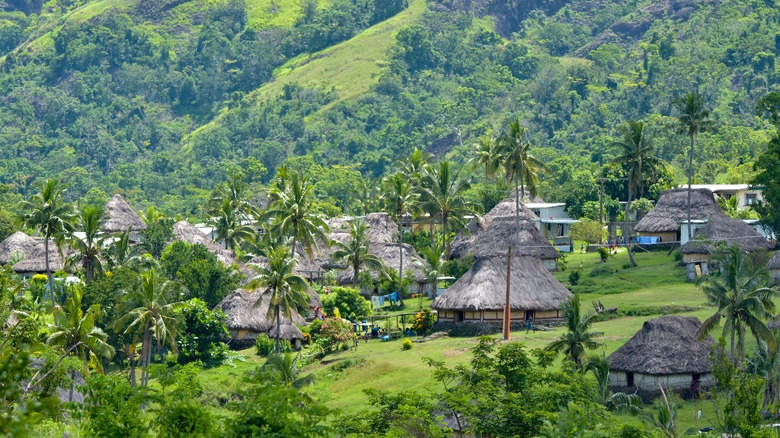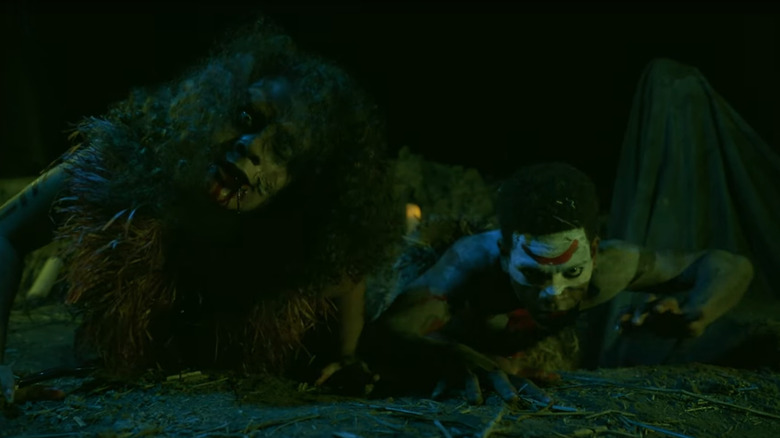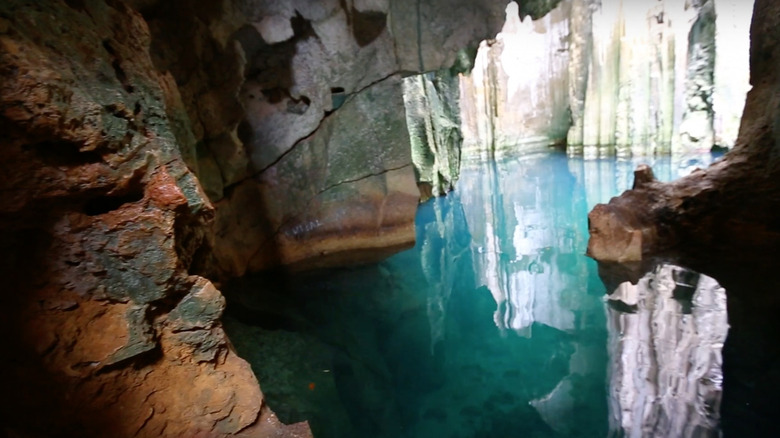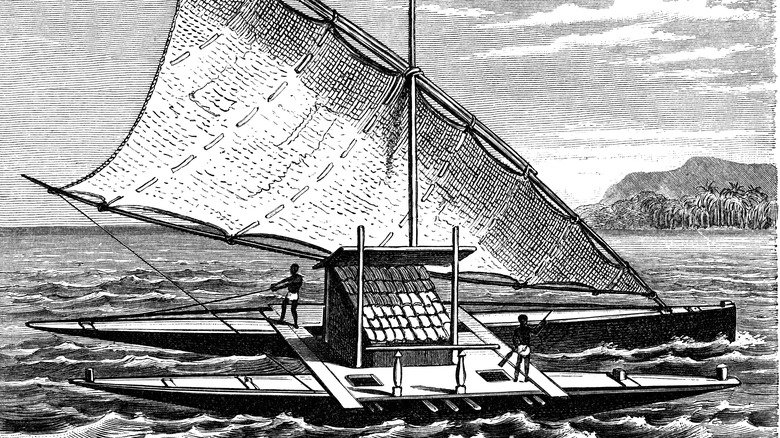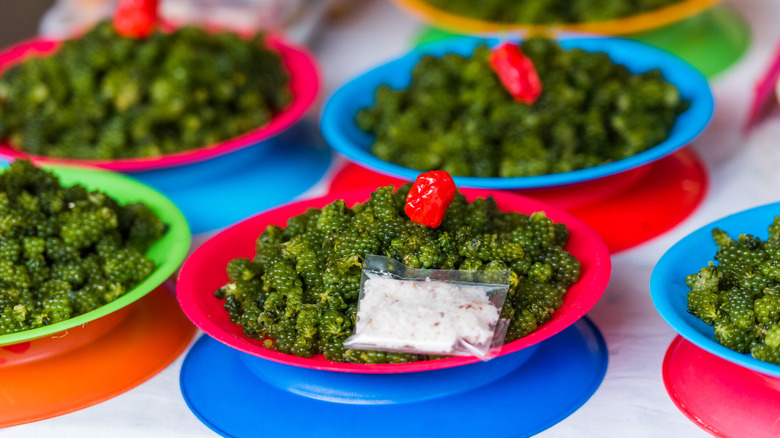Fun Experiences You Can Only Have In Fiji
A nation that comprises more than 300 amazing islands scattered across the South Pacific, Fiji is a paradise on many fronts. It's a great destination for snorkeling and diving, with fabulous reefs and deep marine life. For landlubbers, there are excellent parks and slices of nature waiting to be explored from mountains to coastal walks. And culture vultures will enjoy the unique offerings, from traditional ceremonies to finely choreographed shows.
While the closest large country to Fiji is New Zealand, about 1,300 miles away, there are direct flights to the nation from Los Angeles, San Francisco, and Honolulu. Once there, visitors will find incredible hospitality and warmth, which we've had the good fortune to experience first-hand, and a tropical climate year round. This is a fine country for many types of vacation, whether you are an outdoors enthusiast, a honeymooner looking for romantic destinations, or a backpacker. And it's filled with unique, fun experiences.
Take part in a traditional Fijian kava ceremony
Perhaps you've heard about this ceremony — after all, it's a central part of Fijian culture. Kava is a drink that looks like muddy water and has an earthy, gritty, sharply bitter taste. What makes kava so special is the ceremony attached to it. Kava is made from the root of the yaqona plant, which is crushed and mixed with water and left in a large "tanoa," or bowl. The drink is scooped into a half coconut, in one of two measures — high tide (full cup) or low tide (half cup) — and drinkers go in order around a circle. You are expected to receive the drink with the word Bula (a greeting in Fijian), down the liquid in one go, and end with three claps.
The effect of the root is that it numbs the drinkers' mouths and lips and puts them in a calm, almost Zen-like state. Coupled with the communal aspect of the ceremony, drinking kava is a time for people to get together both physically and emotionally, a moment of unity and harmony. Kava ceremonies can be held simply as a social gathering, or to mark a new home or a special occasion in one's life. For tourists, resorts like the Royal Davui Island Fiji offer a kava ceremony that guests can join.
Dive the soft coral capital of the world
The warm climate of Fiji makes it an easy year-round dive destination. The country has garnered a name for itself as the soft coral capital of the world. Soft corals differ from hard corals in a few obvious ways. Firstly, they don't have a hard structure, a skeleton of sorts, that hard corals display. They also don't produce reef systems (though they are found within reefs) – that is the domain of hard corals. Soft corals can grow in large numbers or colonies, and they often look like grass, fans, or bushes, structures that waft around in the current.
In Fiji, a few soft coral sites stand out. Bligh Water, between the two main islands of Viti Levu and Vanua Levu, is among the most popular, featuring a number of specific sites. Divers will find crinoids, fans, and whips that combine to create a subaquatic forest. Somosomo Strait, in Taveuni, is where to find the Great White Wall, with white corals covering a drop-off. The strait, one of the best places in the world for snorkeling, is also home to the Zoo, where the corals spread out in a variety of colors. The Great Astrolabe Reef, which extends for more than 50 miles off the coast of Kadavu, is one spot for soft corals not to be missed.
Watch a Fijian cultural show
Launched in 2007, Vou is a Fijian dance company that has put together notable performances around the world, promoting Fijian dance in more than 30 countries worldwide. One of its most famous productions is Fiji Untold Show. To some, it might seem a little hokey, a neatly packaged program that draws its fair share of tourists. But the music and dance extravaganza that recounts Fijian lore has been positively received, getting a score of 5.0 on Tripadvisor based on more than 240 reviews.
One reviewer wrote, "The whole cast were such talented dancers, singers and actors and gave us a unique Fijian cultural experience. Pure magic! Definitely worth seeing." The show begins with a barrage of drums before dance and music passages. Likened by the company to a Broadway show, Fiji Untold traces the story of a girl learning about herself. Along the way, the audience will learn about gods that live in the seas, a lizard spirit that transforms itself, and Fijian village life.
Try food from a traditional lovo
A lovo is an oven that sits under the ground, a way to prepare food that is a little like a grill. Seafood, vegetables, and meat can all be prepared in a lovo, slowly cooking to perfection. The process begins with the digging of a shallow pit in the ground. Heated rocks or bricks are set along the base of the pit, and then items to be eaten are placed with herbs in banana leaves and foil atop the rocks. Everything is covered by soil and left to methodically cook.
Lovo as a food preparation method has been a part of Fijian life for centuries, and in villages, it's only usually done for special occasions or important spiritual days. Duties are split between women and men, and the whole enterprise is one where the community unites across generations and families. Among the ingredients that go into a lovo are chicken, lamb, cassava, coconut cream, taro, yams, sweet potatoes, and more. Fresh banana leaves help to bring a smoky flavor to the wrapped parcels, and since lovos tend to be large productions, there is usually plenty of food. Travelers can often enjoy a lovo feast at their resort, like the one offered by the Jean-Michel Cousteau Resort.
Visit the island where Cast Away was filmed
Modriki Island (also known as Monuriki Island) is where the 2000 movie "Cast Away," starring Tom Hanks, was filmed. Fans of celluloid might remember its variegated terrain, from the sandy stretch of beach to the craggy peak. It can be handily visited from the main Fijian island of Viti Levu since it sits a short distance to the west.
There is no infrastructure on Modriki Island, and nobody lives on it, but getting to it has become a popular tourist excursion. You can even get here on a jet ski tour with Jet Ski Island Adventures. On shore, visitors might take some photos of the seminal places where filming took place, and maybe slide into the water for a snorkel. Among the references from the movie, travelers might see "Help Me Wilson" written in coconut husks on the beach, and enjoy views over the water that mirror those seen on the screen.
Enjoy the national Olympic gold medal sport
Named for a school in central England where some believe it originated, rugby has become a global phenomenon. It might not be a household sport in the United States, but it has become important enough, globally, to be featured in the Olympic Games. Rugby Sevens was added to the Olympics in 2016, and one nation has excelled on the international rugby stage. Fiji won gold in the 2016 Rio and 2020 Tokyo Games, a fact that has only added luster to the national sport.
Rugby is played all over the islands with a passion, and you'll see it in a variety of venues. This could be young kids carousing on a field with mountains and the sea in the background, or an international game featuring the Fijian national team at the HFC Bank Stadium, capacity 15,000. "Rugby in our country is second to God," Fiji national rugby team member Nemani Nadolo told The Sydney Morning Herald. Visitors should be sure to catch a game, however informal, during their time on the islands, to see what all the fuss is about.
Jump between days
Some things you only really need to do once to appreciate them, either for the incomparable experience, or the sheer novelty of it. Things in this category might include a cage dive with great whites, trying the world's hottest chili, jumping out of a plane with a parachute, or taking a trip to Las Vegas. Another one to add to that list is to cross the International Date Line by foot. Sure, you can fly across it, and suddenly gain or lose a day, but what's the fun in that?
Much more interesting is to hop back and forth like an over-caffeinated bunny, and rapidly flit from today to tomorrow (or yesterday, it's hard to keep track), and back again. On the island of Taveuni, known as the Garden Island, the International Date Line has its own monument, a map of the island split in two to represent different days, with a line underneath. It's a simple spot that won't wow visitors with its grand design, but it's unique. And the photos will be fun, as you literally travel through time.
Watch a meke
Meke, a traditional Fijian dance, is a fascinating sight, and resorts can arrange for guests to watch one in a village. Pronounced meh-kay, the dance is more than just a visual treat. It's also a method for relaying stories about Fiji's past, through music and choreography. In earlier times, meke was used to send information between villages, back before Fijian was formalized as a written language. Like many things in traditional Fijian society, meke is a group endeavor. Dancers congregate and take turns to perform their pieces of choreography. Performers that aren't dancing lend support, and rhythm, through clapping and singing.
The overall mood is not of introspection and reflection but of celebration and joy. And make isn't a single static discipline or style, but a trove of performative expressions. Cibi meke is fierce, and warrior-like, performed during sports competitions as a way to strike fear in the opposition. A more calm experience is vakamalolo meke, a smooth, rhythmic dance that takes place at times like births and weddings. The seasea meke is more kinetic, accompanied by drum beats, and known for its kicks and rapid movements. Audience members of Fiji Untold Show will see examples of meke during a performance.
Admire the largest Hindu temple in the Southern Hemisphere
Only a 20-minute drive from the international airport in Nadi sits the Sri Siva Subramaniya Temple. It's a shrine filled with color from the towering gopuram, or entry tower, to the statues of deities within. The temple also has the distinction of being the largest Hindu temple in this half of the world. The temple actually spreads over three sections, each one dedicated to separate deities. It's a striking piece of architecture.
Carvers and workmen from India were brought to Fiji for the project, a way to ensure that everything from the statues to the acoustics was in order. It dates back almost a century and reflects the strong Indian presence in the islands. Workers from India began to arrive in Fiji in the late 1800s, brought over to work on the sugar plantations. Today, after ethnic Fijians, Indo-Fijians are the largest population group in the country, and their imprint is evident across the country.
Watch traditional fire walkers
Just south of Viti Levu, the island of Beqa is a rugged, craggy destination. It offers the chance for daring divers to dive with sharks and has fine fishing. What sets it apart from other places in Fiji, however, is the tradition of fire walking. The practice is about 500 years old and began in the highland village of Nakavrovu. Its origins are based on the legend of a young man who aimed to capture an eel to offer as a present to an elder. The man caught something; it wasn't an eel, but a small spirit deity, known as a veli. In exchange for freedom, the veli told the man that he, and his descendants, would receive dominion over fire.
That power continues to this day, and the island's Sawau tribe is the practitioner of this dangerous art. River stones are placed in a pit and heated by a bonfire. When the fire abates, the smoldering rocks are evened out, and the pit is blessed with leaves. A priest ushers in the walkers and, to a soundtrack of chanting and with care, they make their way over the blistering rocks. Beqa has a direct link to the legend of fire walking, and for some, it's the most authentic site for this experience, but resorts across the south of Viti Levu also feature fire-walking performances.
See a Fijian village
While the number of Fijians that live in villages has declined substantially since 1960, a sizeable slice of the population still does. More than 40% of Fijians still call a village home, and a visit to a village there is a special experience. Guests should know a few things about Fiji before embarking on a visit, something that many resorts can arrange. Firstly, travelers should be dressed modestly, so no shorts, tank tops, or showy outfits. Bringing a gift to give to the village chief is always a good idea — kava is always welcome. Always ask, don't assume, before doing things like taking pictures or entering a villager's home — remember that you're a guest in a community and that real people are going about their daily lives, so treat them with respect. And always speak quietly. A loud voice might convey confidence in the U.S., but in Fiji it can cause offense.
Among the most rewarding villages is Navala, where the bures, or homes, have traditional thatch roofs. Located in Viti Levu's northwest, it's an idyllic spot, first formed in the 1800s with the opening of a school. Soon came the addition of bures, huts with a thatch roof that are built on a stone base and have walls made of bamboo or reed. While modernization is evident throughout the country's architectural practices, Navala has made a concerted effort to stick to the old ways and visitors will appreciate the preservation of tradition.
Walk through a maze filled with cannibals
Cannibalism has a long, indefinite history in Fiji. The practice was acknowledged by the British in the 1800s, with news of it filtering through via missionaries. Not all bodies were eaten, only those that were offered to the gods as a sacrifice. The eating of human flesh was reserved for occasional ceremonies, but soon became a fixture of large feasts. And parts of captives were devoured during tribal wars in the 1800s. One chief stood out as the biggest cannibal of all — Udreudre of Rakiraki in Ra is believed to have eaten hundreds of people.
Cannibalism is a thing of the past in Fiji, and visitors to the Fijian Cannibals Chase Horror Maze need not worry about being eaten. This fright-night experience requires participants to navigate through a throng of extras dressed like cannibals. One commenter on Tripadvisor gave a rave review: "Very well executed horror experience! Was jumping around all over the place the whole time. Would definitely recommend." Visitors can expect lots of elaborate costumes, jump scares, and screams galore.
Marvel at the Blue Lagoon caves
The Sawa-i-Lau caves in the Yasawa Islands are where parts of the 1980 movie "Blue Lagoon" were shot. Even without that fame, they are a striking sight not to be missed. Cut and shaped by the actions of wind and water, these limestone formations have a haunting quality to them. There is a legend attached to the cave. A chief hid with his love in the cave after her family planned to marry her to another chief. He swam into the cave daily with food for her, and eventually, they fled to an island to live a life in harmony.
Another legend claims that this is the home of an old god called Ulutini. Tour operators take tourists into the caves, some of which are dark and mystical, others of which are lit from above from holes in the ceiling. Daredevils can climb up rock ledges and leap into the water, or access caverns via underwater tunnels. The water is clear, still, and beautifully blue.
Sail on a traditional Fijian canoe
The drua canoe is a time-worn Fijian invention, and visitors can board one with the Drua Experience. Visually, it appears almost like a catamaran, with two parallel hulls, a small platform and housing on top, and a large sail to capture the wind. Travelers can choose from a range of cruises, though whatever the trip, the crew will share their insights into Fiji's history and waters. You might even get some kava onboard. Another traditional method of plying the country's waterways is aboard a bamboo raft.
The ramshackle vessels, which look as rudimentary as they sound, are literally made of stalks of bamboo lashed together. With Discover Fiji Tours, travelers will have the chance to board a bamboo raft as it gently winds its way along the Navua River. It's a peaceful experience, the current carrying the vessel along, boat hands ready with bamboo poles to steer away from the shallows or riverbank.
Learn about Nama harvesting
Wild sea grapes, or Nama, have a restorative effect on the skin. Research has shown that Nama, which is actually a variety of seaweed found in Fiji, is packed with minerals. These elements help the skin to maintain hydration, which lets it stay firm and supple. Cosmetics companies like Nama Fiji meld Nama into its products, paying rural women who dive to source the raw material a fair wage. It's laborious work, requiring harvesters to spend hours in the water for days, but it allows them to provide for their families and communities.
Guests that sign up for the Nama Life tour with Rosie Living can get an inside view onto how Nama is gathered. The wellness travel provider flies visitors to Naviti island to show them how Nama is processed. Guests learn about methods used to collect and store sea grapes, and even wade into the ocean to find Nama themselves. But the trip isn't all about work. It also includes a local lunch, and a massage that uses Nama in the treatment.
